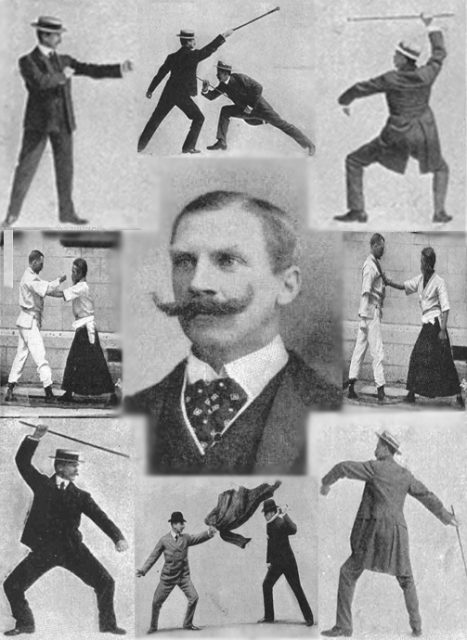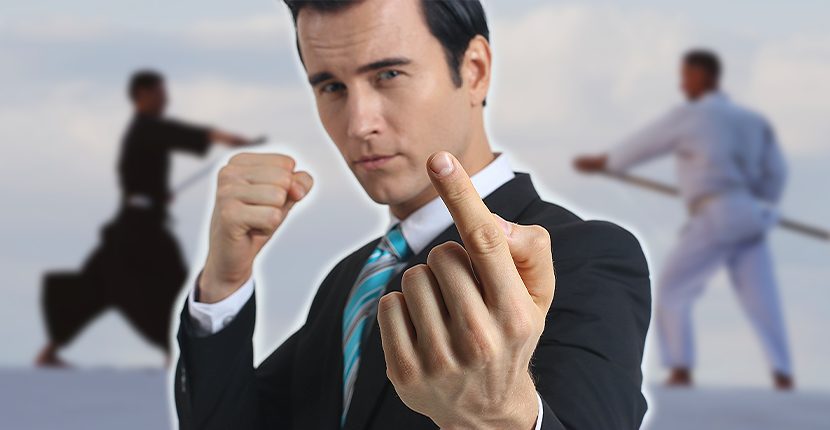Bartitsu could be the quirkiest and coolest of all martial arts forms. At the dawn of the 20th century, a lot of things about Japan were still wrapped in a veil of mystique and prejudice. People from Europe belonging to all walks of life traveled to the distant Land of the Rising Sun in search of answers about a country so different from their own.
One Englishman who ended up in Japan in the mid-1890s as a railroad engineer became fascinated with the country’s martial-arts tradition, especially jujitsu. His name was Edward William Barton-Wright, the founder of the first Western mixed martial art intended for self-defense―Bartitsu.
As mentioned, Barton-Wright became fairly interested in the Japanese fighting skills nurtured by jujitsu, adding it to his earlier knowledge of European martial arts like boxing. To this mix, he included the more street-oriented styles such as the French kickboxing, also known as savate, and stick fighting, cane de combat, which promoted the use of a walking cane or an umbrella as a weapon of self-defense. The basis for a new and eclectic martial art was born.
In 1899, the Englishman returned to London with the intention of further developing his idea of mixing these styles in order to create his own special blend of martial arts, intended for well-to-do gentlemen who were facing the rise of street crime in Edwardian England.
In pursuing such an endeavor, he first started publicizing articles, mainly for Pearson’s Magazine, in which he explained his methods, intentions, and overall philosophy of Bartitsu. The name itself was coined by Barton-Wright as the combination of his last name and the word “jujitsu.”

After popularizing the subject a bit within the British public, it was time for the next step. The Bartitsu Academy of Arms and Physical Culture was formed. It soon became commonly known as the Bartitsu Club and garnered followers along the way, who became eager to learn this novel fighting style.
All of a sudden, many rich Londoners were seeking lessons from the Bartitsu master, Edward William Barton-Wright, who then assembled teachers from both Europe and Japan in order to further develop his martial arts and to provide a thorough course in Bartitsu―one that promised self-defense in cases of assault, mugging, or other ordeals on the cosmopolitan streets of London.
Among others, there were Kaneo Tani, Seizo Yamamoto, and Yukio Tani, whose arrival was arranged via correspondence between Barton-Wright and the esteemed Japanese athlete and educator Kanō Jigorō, who was the legitimate founder of yet another martial art―judo.
As for the European part of the teaching crew, the most notable were Swiss wrestling champion Armand Cherpillod, and the French Master-at arms Pierre Vigny. The approach used by the club incited larger interest in the original Japanese forms as well, as the distant Asian country seemed closer than ever within the compounds of the Bartitsu dojo.
By 1901, the club included fencing lessons as well as breathing exercises, which became an obligatory part of the Bartitsu curriculum.
The teaching staff often organized spectacular demonstrations in which they handled a number of opponents by using the newly-developed techniques of Bartitsu. The style was primarily introduced as a means to tackle multiple attackers, as Barton-Wright himself once demonstrated by fighting off seven opponents at once, all of whom were larger in size than him.
This accomplishment earned him a lot of respect―so much so that he was invited to make an appearance before Edward, Prince of Wales. Unfortunately, due to an injury from a bicycling accident shortly before the scheduled appearance, he had to cancel his visit. Some speculate that the real reason for not appearing before the Prince was an injury sustained during a bar fight, but both versions of the story remain rather uncertain.
Even though Barton-Wright failed to meet the Prince of Wales, his skill was gaining in popularity. It was immortalized as the fighting skill worthy of a true gentleman by the creator of Sherlock Holmes, Arthur Conan Doyle. In the story The Adventure of the Empty House, written in 1903, Holmes mentioned having “some knowledge, however, of baritsu, or the Japanese system of wrestling.”
Apparently, Doyle wasn’t fully familiarized with Barton-Wright’s technique, or its exact name (as he calls it “baritsu”), but the reference remains clear and it serves as one of the testimonies that such a fad even existed.
Even though the martial art did achieve a significant growth in popularity during its first few years, by 1902, it was all over. The cost of tuition seemed to be just too high, while the club developed a rather elitist stand towards the martial art they were teaching. Before entering the club, a person was instructed to attend a number of private one-on-one lessons by trainers employed by Barton-Wright. The Bartitsu club soon started to stagnate. Those who showed interest were losing it, and no new faces appeared. The whole fad deflated.
The club closed, and many of the teachers went on to establish their own schools, or simply to monetize their skills and knowledge while working as personal physicians, trainers, or athletes.
As for Barton-Wright, he made several attempts at bringing Bartitsu once again into the center of attention but failed. By the 1920s, this defensive hand-to-hand combat skill became all but forgotten. Still, it remained a subject of study and research as many experts found interesting concepts and ideas that were built into the foundation of Bartitsu.
